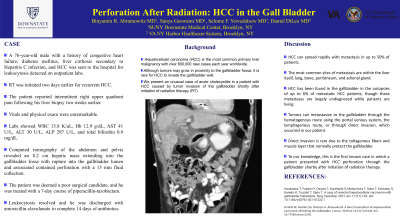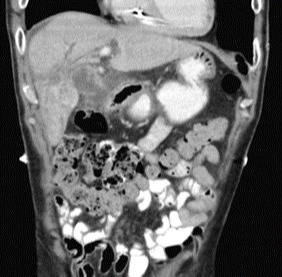Sunday Poster Session
Category: Liver
P1109 - Perforation After Radiation: HCC in the Gallbladder
Sunday, October 22, 2023
3:30 PM - 7:00 PM PT
Location: Exhibit Hall

Has Audio
- BA
Binyamin R. Abramowitz, MD
SUNY Downstate Health Sciences University
Brooklyn, New York
Presenting Author(s)
Binyamin R. Abramowitz, MD1, Sanya Goswami, MD1, Selome F. Yewedalsew, MD1, Daniel Dileo, MD2
1SUNY Downstate Health Sciences University, Brooklyn, NY; 2Brooklyn VA Medical Center, Brooklyn, NY
Introduction: Hepatocellular carcinoma (HCC) is the most common primary liver malignancy with over 800,000 new cases each year worldwide. Although tumors may grow in proximity to the gallbladder fossa, it is rare for HCC to invade the gallbladder wall. We present an unusual case of acute cholecystitis in a patient with HCC caused by tumor invasion of the gallbladder shortly after initiation of radiation therapy (RT).
Case Description/Methods: A 76-year-old male with a history of congestive heart failure, diabetes mellitus, liver cirrhosis secondary to Hepatitis C infection, and HCC was sent to the hospital for leukocytosis detected on outpatient labs. RT was initiated two days earlier for recurrent HCC. The patient reported intermittent right upper quadrant pain following his liver biopsy two weeks earlier. Vitals and physical exam were unremarkable. Labs showed WBC 13.8 K/uL, Hb 12.9 g/dL, AST 41 U/L, ALT 30 U/L, ALP 297 U/L, and total bilirubin 0.9 mg/dL. Computed tomography of the abdomen and pelvis revealed an 8.2 cm hepatic mass extending into the gallbladder fossa with rupture into the gallbladder lumen and associated contained perforation with a 13 mm fluid collection. The patient was deemed a poor surgical candidate, and he was treated with a 7-day course of piperacillin-tazobactam. Leukocytosis resolved and he was discharged with amoxicillin-clavulanate to complete 14 days of antibiotics.
Discussion: HCC can spread rapidly with metastasis in up to 50% of patients. The most common sites of metastasis are within the liver itself, lung, bone, peritoneum, and adrenal gland. HCC has been found in the gallbladder in the autopsies of up to 6% of metastatic HCC patients, though these metastases are largely undiagnosed while patients are living. Tumors can metastasize to the gallbladder through the hematogenous route using the portal venous system, the lymphagenous route, or through direct invasion, which occurred in our patient. Direct invasion is rare due to the collagenous fibers and muscle layer that normally protect the gallbladder. To our knowledge, this is the first known case in which a patient presented with HCC perforation through the gallbladder shortly after initiation of radiation therapy.

Disclosures:
Binyamin R. Abramowitz, MD1, Sanya Goswami, MD1, Selome F. Yewedalsew, MD1, Daniel Dileo, MD2. P1109 - Perforation After Radiation: HCC in the Gallbladder, ACG 2023 Annual Scientific Meeting Abstracts. Vancouver, BC, Canada: American College of Gastroenterology.
1SUNY Downstate Health Sciences University, Brooklyn, NY; 2Brooklyn VA Medical Center, Brooklyn, NY
Introduction: Hepatocellular carcinoma (HCC) is the most common primary liver malignancy with over 800,000 new cases each year worldwide. Although tumors may grow in proximity to the gallbladder fossa, it is rare for HCC to invade the gallbladder wall. We present an unusual case of acute cholecystitis in a patient with HCC caused by tumor invasion of the gallbladder shortly after initiation of radiation therapy (RT).
Case Description/Methods: A 76-year-old male with a history of congestive heart failure, diabetes mellitus, liver cirrhosis secondary to Hepatitis C infection, and HCC was sent to the hospital for leukocytosis detected on outpatient labs. RT was initiated two days earlier for recurrent HCC. The patient reported intermittent right upper quadrant pain following his liver biopsy two weeks earlier. Vitals and physical exam were unremarkable. Labs showed WBC 13.8 K/uL, Hb 12.9 g/dL, AST 41 U/L, ALT 30 U/L, ALP 297 U/L, and total bilirubin 0.9 mg/dL. Computed tomography of the abdomen and pelvis revealed an 8.2 cm hepatic mass extending into the gallbladder fossa with rupture into the gallbladder lumen and associated contained perforation with a 13 mm fluid collection. The patient was deemed a poor surgical candidate, and he was treated with a 7-day course of piperacillin-tazobactam. Leukocytosis resolved and he was discharged with amoxicillin-clavulanate to complete 14 days of antibiotics.
Discussion: HCC can spread rapidly with metastasis in up to 50% of patients. The most common sites of metastasis are within the liver itself, lung, bone, peritoneum, and adrenal gland. HCC has been found in the gallbladder in the autopsies of up to 6% of metastatic HCC patients, though these metastases are largely undiagnosed while patients are living. Tumors can metastasize to the gallbladder through the hematogenous route using the portal venous system, the lymphagenous route, or through direct invasion, which occurred in our patient. Direct invasion is rare due to the collagenous fibers and muscle layer that normally protect the gallbladder. To our knowledge, this is the first known case in which a patient presented with HCC perforation through the gallbladder shortly after initiation of radiation therapy.

Figure: An 8.2 cm mass extending into the gall bladder fossa with a defect in the enhancing wall of the tumor indicating rupture into the gall bladder lumen.
Disclosures:
Binyamin Abramowitz indicated no relevant financial relationships.
Sanya Goswami indicated no relevant financial relationships.
Selome Yewedalsew indicated no relevant financial relationships.
Daniel Dileo indicated no relevant financial relationships.
Binyamin R. Abramowitz, MD1, Sanya Goswami, MD1, Selome F. Yewedalsew, MD1, Daniel Dileo, MD2. P1109 - Perforation After Radiation: HCC in the Gallbladder, ACG 2023 Annual Scientific Meeting Abstracts. Vancouver, BC, Canada: American College of Gastroenterology.
